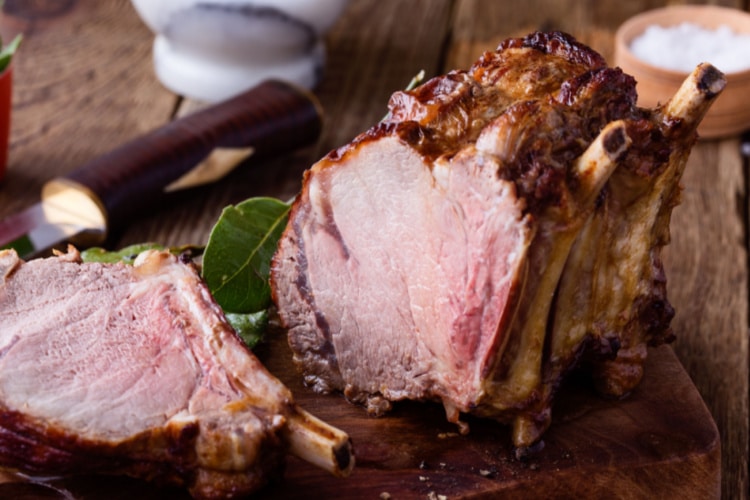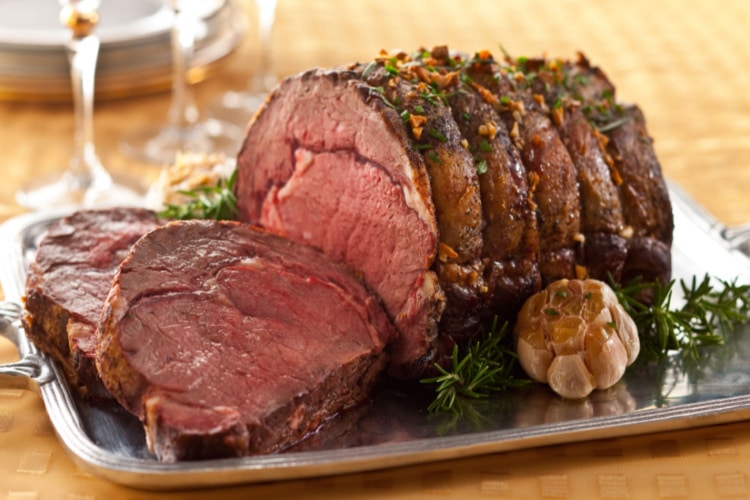Prime rib and rib roast are often used interchangeably, despite having a few significant differences. While they come from the same cut of meat, check out these additional factors that can help you distinguish whether you’re referring to rib roast vs. prime rib.
Differences Between Rib Roast and Prime Rib
The main difference between rib roast and prime rib is that prime rib gets roasted with the bone in, whereas rib roast may or may not have the bone since it’s usually sold as a steak.
Additional Differences
- Preparation: You have to roast prime rib after you completely thaw it and season it beforehand, whereas the rib roast may or may not have the bone in it. You can grill it or cook it in a frying pan as you please.
- Cost: Typically, prime rib is cheaper than rib roast, but that depends on several additional factors. For example, how much meat are you purchasing?
If you buy a large portion of prime rib, it might cost you more than one slice of a rib roast sold as a steak. However, in general, you will have to pay more for the prime cuts of the rib roast.
- Texture: The rib roast has a tougher texture than the prime rib because of how you prepare them. You sear the prime rib first and then cool it slowly over high heat for a long time.
This method lends it to be extremely tender when it finishes. You grill it quickly over the high heat with rib roast, and you’re trying to char it afterward. Therefore, the meat isn’t as tender.
- Cut Location: The meat from a prime rib comes from the entire export rib, which means they take the meat from ribs 6-12 as a whole.
With rib roast, you can cut the meat in multiple ways depending on how you want to prepare it and where you want small chunks or a steak.
- Appearance: A cut of the prime rib has more fat and bones on it, which usually contributes to better flavor. The rib roast, or ribeye, generally has a lot of flavor because of marbling, but the prime rib’s bone gives it the advantage.
- Time: Prime rib takes much more time to cook since you’re usually cooking an entire roast, while rib roast can be complete in minutes if you cook it like a steak.
Comparison Table
| CHARACTERISTICS | RIB ROAST | PRIME RIB |
| Alternative Names | Ribeye | Standing rib roast |
| Price | Generally costs less because you buy it as a steak, but it depends on how much of it you purchase | If you purchase the whole roast, the prime rib will be slightly more expensive |
| Bones | It may or may not include the bones when you purchase it | It comes with the bone in |
| Cooking | You pan-fry or grill rib roast | You roast the prime rib, typically standing |
What Does Rib Roast Taste Like?

This piece of meat stands out for its rich and buttery taste. The rib roast is a cut of steak called ribeye. This cut of meat comes from under the beef animal’s rib area—specifically between the 6th and 12th ribs. The marbling fat in ribeyes gives the steak its classic taste.
Before you cook the roast, it should already be cut. The rib roast is also sold mostly as steak because the bones are taken out instead of being left intact, as is the case with prime rib.
What’s more, this area is used for much more movement and has to bear weight. When muscles get used very little or not at all, they tend to be more tender.
Cooking the ribeye allows the marbled fat to render, enabling the rendered fat to base the steak from the inside. This infuses the steak with more juiciness, making for a delicious steak.
What Does Prime Rib Taste Like?

Prime rib has an unmistakably recognizable signature flavor. This cut of meat is tender, rich, juicy, and chock full of intense beef flavor.
Prime rib or standing rib roast is one of the nine primal cuts of beef, which is where the name “prime rib” derives. In most cases, prime rib is a cut of meat that is roasted standing—which is why prime rib is also known as standing roast.
The advantage of roasting the prime rib while standing is that the meat doesn’t touch the grill or pan. Most of the time, you cook prime rib with bone.
During the cooking process, keeping the bone in adds more flavor and moisture to the meat.
When cooked to a medium-rare, prime rib is at its best. Once you begin to cook it past medium, it starts to become significantly less tender.
Which Is Better: Rib Roast or Prime Rib
Neither cut is better than the other. The main difference is in the way you cook them. Even though they are from the same cut of beef, they serve different purposes and get prepared differently.
Ribeyes are at their best when seared on a hot cast-iron pan or cooked on a grill. If you can help it, get the ribeyes cooked over direct heat quickly.
On the other hand, prime rib gets cooked in the form of a roast. Typically, the surface of prime rib gets seared first to make a crust right before being placed in the oven to finish slow cooking.
Ribeyes are better suited for a small barbecue or even date night since they cook within minutes. Prime rib is a little more involved and requires time for proper cooking.
Consequently, prime ribs are an excellent choice for the holidays when you have plenty of mouths to feed.
Be mindful of the drastic difference in flavor profile—which is more of a consequence of how they are prepared. A ribeye is a way to go for those who like a char and crisp flavor. However, the slow-roasting prime rib will make for a tender cut of beef.
Lastly, remember, when it comes to rib roast vs. prime rib, they are two different terms used to describe the same cut of meat. The most siutable choice for you will largely depend on how you like to eat this selection of meat.






